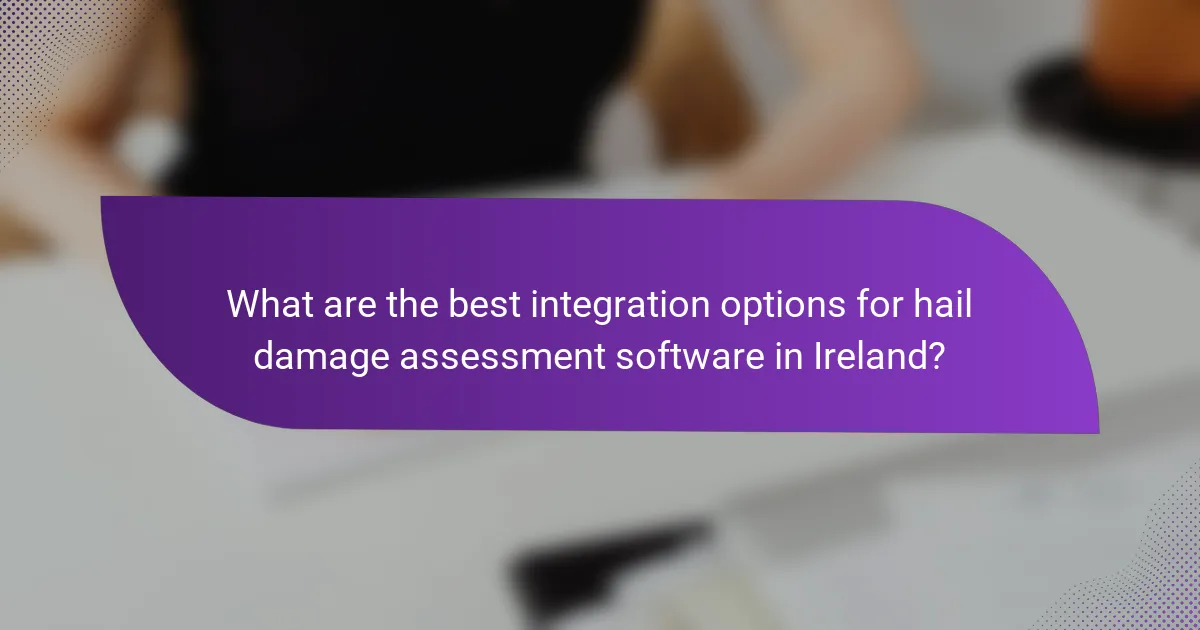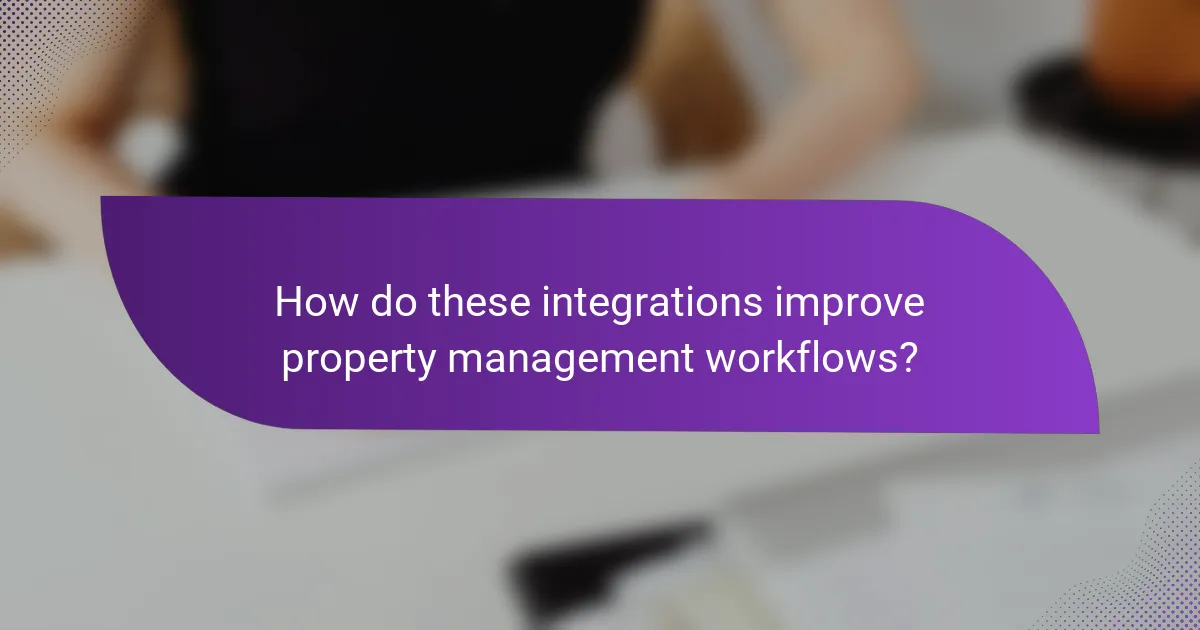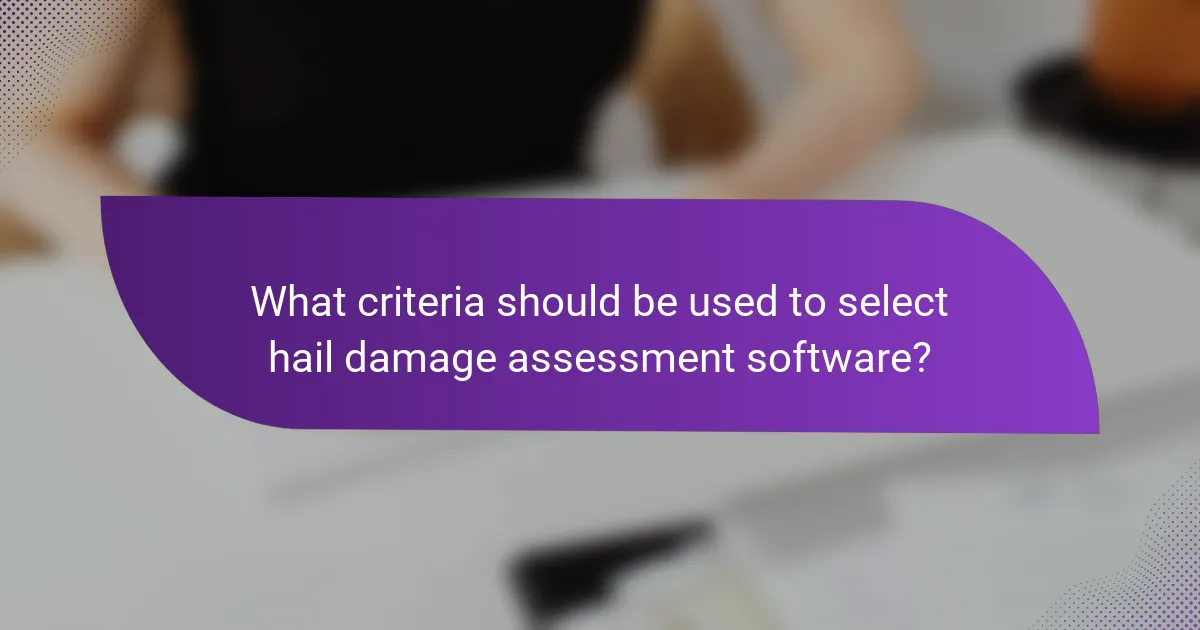When evaluating hail damage assessment software for property management, it’s essential to explore various integration options such as cloud-based platforms, API integrations, and mobile applications. Each integration type presents distinct advantages that can streamline workflows, improve data accuracy, and enhance overall efficiency. By carefully considering these options, property managers can make informed decisions that align with their operational needs and optimize resource allocation.

What are the best integration options for hail damage assessment software in Ireland?
The best integration options for hail damage assessment software in Ireland include cloud-based platforms, API integrations, mobile applications, third-party software, and custom solutions. Each option offers unique benefits and considerations that property managers should evaluate based on their specific needs and operational workflows.
Cloud-based platforms
Cloud-based platforms provide a flexible and scalable solution for hail damage assessment. These platforms allow users to access data from anywhere, facilitating collaboration among property management teams and adjusters. Popular options often include subscription models that can range from monthly fees to annual contracts.
When selecting a cloud-based platform, consider factors such as data security, ease of use, and integration capabilities with existing systems. Look for providers that comply with local data protection regulations, such as the General Data Protection Regulation (GDPR).
API integrations
API integrations enable seamless communication between hail damage assessment software and other systems, such as property management or insurance platforms. This option allows for real-time data exchange, reducing manual entry and minimizing errors.
When implementing API integrations, ensure that the APIs are well-documented and supported by the software vendor. Evaluate the potential costs associated with development and maintenance, as well as the technical expertise required for successful integration.
Mobile applications
Mobile applications provide on-the-go access to hail damage assessment tools, making it easier for field assessors to capture data and images directly from the site. This immediacy can enhance the accuracy of assessments and speed up the claims process.
Choose mobile applications that are user-friendly and compatible with various devices. Consider offline functionality, as assessors may work in areas with limited internet connectivity. Look for apps that allow easy synchronization with cloud-based systems for efficient data management.
Third-party software
Third-party software can complement hail damage assessment tools by offering additional features, such as advanced analytics or reporting capabilities. These solutions can enhance the overall functionality of your assessment process.
When considering third-party software, evaluate its compatibility with your existing systems and the potential for additional costs. Ensure that the software adheres to industry standards and provides reliable customer support for troubleshooting.
Custom solutions
Custom solutions are tailored to meet the specific needs of property management firms dealing with hail damage assessments. These solutions can integrate various functionalities, such as data collection, reporting, and compliance tracking, into a single platform.
Developing a custom solution often requires a significant investment in time and resources. Engage with experienced developers who understand the property management landscape and can create a solution that aligns with your operational goals. Regularly assess the solution’s performance to ensure it continues to meet evolving needs.

How do these integrations improve property management workflows?
Integrations for hail damage assessment software significantly enhance property management workflows by automating processes, reducing manual tasks, and improving data accuracy. These efficiencies lead to faster decision-making and better resource allocation, ultimately benefiting property managers and owners alike.
Streamlined data collection
Streamlined data collection allows property managers to gather information quickly and efficiently. By integrating hail damage assessment tools with existing property management systems, data can be automatically populated from various sources, minimizing the need for manual entry.
This integration can include features like mobile data capture, where inspectors can input findings directly into the system via smartphones or tablets. This approach reduces errors and ensures that all relevant information is collected in real-time.
Real-time reporting
Real-time reporting provides property managers with immediate access to critical information regarding hail damage assessments. With integrated systems, reports can be generated instantly, allowing for timely analysis and decision-making.
For instance, property managers can quickly assess the extent of damage across multiple properties and prioritize repairs based on severity. This responsiveness can significantly reduce downtime and associated costs.
Enhanced collaboration
Enhanced collaboration is achieved through shared access to data and insights among various stakeholders, including property managers, maintenance teams, and insurance adjusters. Integration facilitates seamless communication, ensuring everyone is on the same page regarding damage assessments and repair plans.
Using collaborative platforms, teams can discuss findings, share documents, and track progress in real-time, which fosters a more cohesive approach to property management and maintenance.
Automated claims processing
Automated claims processing streamlines the insurance claim submission process for hail damage. By integrating assessment software with claims management systems, property managers can automatically generate and submit claims based on the collected data.
This automation reduces the time spent on paperwork and minimizes the risk of errors, which can delay claims approval. Property managers should ensure that their systems comply with local insurance regulations to facilitate smoother processing.

What criteria should be used to select hail damage assessment software?
When selecting hail damage assessment software, consider integration capabilities, user interface design, cost-effectiveness, and customer support. These criteria ensure the software meets operational needs and enhances efficiency in property management.
Integration capabilities
Integration capabilities refer to how well the software connects with existing systems, such as property management platforms and insurance databases. Look for software that supports APIs or has built-in integrations with popular tools to streamline workflows.
Assess compatibility with your current technology stack. For instance, if your property management system is cloud-based, ensure the hail damage assessment software can easily integrate without extensive modifications.
User interface design
A user-friendly interface is crucial for efficient operation. The software should have an intuitive layout that minimizes the learning curve for staff. Features like drag-and-drop functionality and clear navigation enhance usability.
Consider conducting user testing with potential end-users to evaluate the interface. A well-designed interface can significantly reduce the time spent on training and improve overall productivity.
Cost-effectiveness
Cost-effectiveness involves evaluating the software’s pricing relative to its features and benefits. Look for transparent pricing models that include all costs, such as subscription fees, setup charges, and potential upgrade costs.
Compare the total cost of ownership over time, including maintenance and support. Aim for software that offers a good balance between affordability and essential features, ensuring you get value for your investment.
Customer support
Reliable customer support is vital for resolving issues quickly and minimizing downtime. Check if the software provider offers multiple support channels, such as phone, email, and live chat, and their availability hours.
Research customer reviews to gauge the quality of support. A provider with a strong reputation for responsive and effective customer service can significantly enhance your experience with the software.

What are the pricing models for hail damage assessment software?
The pricing models for hail damage assessment software typically include subscription-based pricing, one-time purchases, and freemium options. Each model has its own advantages and considerations, making it essential to evaluate which aligns best with your property management needs.
Subscription-based pricing
Subscription-based pricing involves paying a recurring fee, often monthly or annually, for access to the software. This model allows for continuous updates and support, which can be beneficial for staying current with technology and regulatory changes.
When considering subscription options, look for features such as scalability and user limits. Costs can range from low tens to several hundreds of dollars per month, depending on the software’s capabilities and the number of users.
One-time purchase
A one-time purchase model requires an upfront payment for a perpetual license to use the software. This option may be appealing for organizations that prefer to avoid ongoing fees and want full ownership of the software.
However, with a one-time purchase, you may miss out on future updates and support unless you pay for upgrades separately. Prices for one-time purchases can vary widely, often starting in the low hundreds and going up to several thousand dollars based on the software’s features.
Freemium options
Freemium options provide basic functionality at no cost, with the opportunity to upgrade to a paid version for advanced features. This model allows users to test the software before committing financially, which can be advantageous for property managers exploring different tools.
While freemium models can be appealing, be aware of potential limitations in features and support. It’s crucial to assess whether the free version meets your needs or if the paid upgrade justifies the cost based on your assessment requirements.
